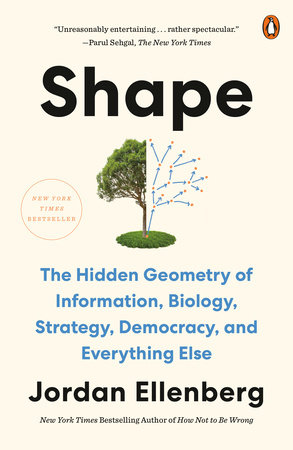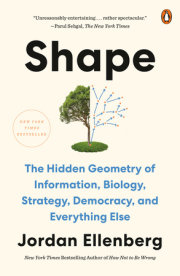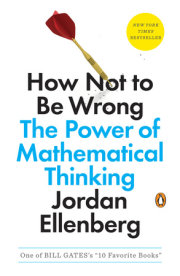Chapter 1
"I Vote for Euclid"
In 1864, the Reverend J. P. Gulliver, of Norwich, Connecticut, recalled a conversation with Abraham Lincoln about how the president had acquired his famously persuasive rhetorical skill. The source, Lincoln said, was geometry.
In the course of my law-reading I constantly came upon the word demonstrate. I thought, at first, that I understood its meaning, but soon became satisfied that I did not. . . . I consulted Webster's Dictionary. That told of "certain proof," "proof beyond the possibility of doubt;" but I could form no idea what sort of proof that was. I thought a great many things were proved beyond a possibility of doubt, without recourse to any such extraordinary process of reasoning as I understood "demonstration" to be. I consulted all the dictionaries and books of reference I could find, but with no better results. You might as well have defined blue to a blind man. At last I said, "Lincoln, you can never make a lawyer if you do not understand what demonstrate means;" and I left my situation in Springfield, went home to my father's house, and staid there till I could give any propositions in the six books of Euclid at sight. I then found out what "demonstrate" means, and went back to my law studies.
Gulliver was fully on board, replying, "No man can talk well unless he is able first of all to define to himself what he is talking about. Euclid, well studied, would free the world of half its calamities, by banishing half the nonsense which now deludes and curses it. I have often thought that Euclid would be one of the best books to put on the catalogue of the Tract Society, if they could only get people to read it. It would be a means of grace." Lincoln, Gulliver tells us, laughed and agreed: "I vote for Euclid."
Lincoln, like the shipwrecked John Newton, had taken up Euclid as a source of solace at a rough time in his life; in the 1850s, after a single term in the House of Representatives, he seemed finished in politics and was trying to make a living as an ordinary traveling lawyer. He had learned the rudiments of geometry in his earlier job as a surveyor and now aimed to fill the gaps. His law partner William Herndon, who often had to share a bed with Lincoln at small country inns in their sojourns around the circuit, recalls Lincoln's method of study; Herndon would fall asleep, while Lincoln, his long legs hanging over the edge of the bed, would stay up late into the night with a candle lit, deep in Euclid.
One morning, Herndon came upon Lincoln in their offices in a state of mental disarray:
He was sitting at the table and spread out before him lay a quantity of blank paper, large heavy sheets, a compass, a rule, numerous pencils, several bottles of ink of various colors, and a profusion of stationery and writing appliances generally. He had evidently been struggling with a calculation of some magnitude, for scattered about were sheet after sheet of paper covered with an unusual array of figures. He was so deeply absorbed in study he scarcely looked up when I entered.
Only later in the day did Lincoln finally get up from his desk and tell Herndon that he had been trying to square the circle. That is, he was trying to construct a square with the same area as a given circle, where to "construct" something, in proper Euclidean style, is to draw it on the page using just two tools, a straightedge and a compass. He worked at the problem for two straight days, Herndon remembers, "almost to the point of exhaustion."
I have been told that the so-called squaring of the circle is a practical impossibility, but I was not aware of it then, and I doubt if Lincoln was. His attempt to establish the proposition having ended in failure, we, in the office, suspected that he was more or less sensitive about it and were therefore discreet enough to avoid referring to it.
Squaring the circle is a very old problem, whose fearsome reputation I suspect Lincoln might actually have known; "squaring the circle" has been a metaphor for a difficult or impossible task for a long time. Dante name-checks it in the Paradiso: "Like the geometer who gives his all trying to square the circle, and still can't find the idea he needs, that's how I was." In Greece, where it all started, a standard exasperated comment when someone is making a task harder than necessary is to say, "I wasn't asking you to square the circle!"
There is no reason one needs to square a circle-the problem's difficulty and fame is its own motivation. People with a conquering mentality tried to square circles from antiquity until 1882, when Ferdinand von Lindemann proved it couldn't be done (and even then a few die-hards persisted; okay, even now). The seventeenth-century political philosopher Thomas Hobbes, a man whose confidence in his own mental powers is not fully captured by the prefix "over," thought he'd cracked it. Per his biographer John Aubrey, Hobbes discovered geometry in middle age and quite by accident:
Being in a Gentleman's Library, Euclid's Elements lay open, and 'twas the 47 El. Libri 1. He read the Proposition. By G_, saydd he (he would now and then sweare an emphaticall Oath by way of emphasis) this is impossible! So he reads the Demonstration of it, which referred him back to such a Proposition; which proposition he read. That referred him back to another, which he also read. Et sic deinceps that at last he was demonstratively convinced of that trueth. This made him in love with Geometry.
Hobbes was constantly publishing new attempts and getting in petty feuds with the major British mathematicians of the time. At one point, a correspondent pointed out that one of his constructions was not quite correct because two points P and Q he claimed to be equal were actually at very slightly different distances from a third point R; 41 and about 41.012 respectively. Hobbes retorted that his points were big enough in extent to cover such a minor difference. He went to his grave still telling people he'd squared the circle.
An anonymous commentator in 1833, reviewing a geometry textbook, described the typical circle-squarer in a way that quite precisely depicts both Hobbes, two centuries prior, and intellectual pathologies still hanging around here in the twenty-first:
[A]ll they know of geometry is, that there are in it some things which those who have studied it most have long confessed themselves unable to do. Hearing that the authority of knowledge bears too great a sway over the minds of men, they propose to counterbalance it by that of ignorance: and if it should chance that any person acquainted with the subject has better employment than hearing them unfold hidden truths, he is a bigot, a smotherer of the light of truth, and so forth.
In Lincoln, we find a more appealing character: enough ambition to try, enough humility to accept that he hadn't succeeded.
What Lincoln took from Euclid was the idea that, if you were careful, you could erect a tall, rock-solid building of belief and agreement by rigorous deductive steps, story by story, on a foundation of axioms no one could doubt: or, if you like, truths one holds to be self-evident. Whoever doesn't hold those truths to be self-evident is excluded from discussion. I hear the echoes of Euclid in Lincoln's most famous speech, the Gettysburg Address, where he characterizes the United States as "dedicated to the proposition that all men are created equal." A "proposition" is the term Euclid uses for a fact that follows logically from the self-evident axioms, one you simply cannot rationally deny.
Lincoln wasn't the American first to look for a basis of democratic politics in Euclidean terms; that was the math-loving Thomas Jefferson. Lincoln wrote, in a letter read at an 1859 Jefferson commemoration in Boston he was unable to attend:
One would start with great confidence that he could convince any sane child that the simpler propositions of Euclid are true; but, nevertheless, he would fail, utterly, with one who should deny the definitions and axioms. The principles of Jefferson are the definitions and axioms of free society.
Jefferson had studied Euclid at William and Mary as a young man, and esteemed geometry highly ever afterward. While vice president, Jefferson took the time to answer a letter from a Virginia student about his proposed plan of academic study, saying: "Trigonometry, so far as this, is most valuable to every man, there is scarcely a day in which he will not resort to it for some of the purposes of common life" (though he describes much of higher mathematics as "but a luxury; a delicious luxury indeed; but not to be indulged in by one who is to have a profession to follow for his subsistence").
In 1812, retired from politics, Jefferson wrote to his predecessor in the presidency, John Adams:
I have given up newspapers in exchange for Tacitus and Thucydides, for Newton and Euclid; and I find myself much the happier.
Here we see a real difference between the two geometer-presidents. For Jefferson, Euclid was part of the classical education required of a cultivated patrician, of a piece with the Greek and Roman historians and the scientists of the Enlightenment. Not so for Lincoln, the self-educated rustic. Here's the Reverend Gulliver again, recalling Lincoln recalling his childhood:
I can remember going to my little bedroom, after hearing the neighbors talk of an evening with my father, and spending no small part of the night walking up and down, and trying to make out what was the exact meaning of some of their, to me, dark sayings. I could not sleep, though I often tried to, when I got on such a hunt after an idea, until I had caught it; and when I thought I had got it, I was not satisfied until I had repeated it over and over, until I had put it in language plain enough, as I thought, for any boy I knew to comprehend. This was a kind of passion with me, and it has stuck by me, for I am never easy now, when I am handling a thought, till I have bounded it north and bounded it south, and bounded it east and bounded it west. Perhaps that accounts for the characteristic you observe in my speeches.
This is not geometry, but it's the mental habit of the geometer. You don't settle for leaving things half-understood; you boil down your thoughts and trace back their steps of reason, just as Hobbes had amazedly watched Euclid do. This kind of systematic self-perception, Lincoln thought, was the only way out of confusion and darkness.
For Lincoln, unlike Jefferson, the Euclidean style isn't something belonging to the gentleman or the possessor of a formal education, because Lincoln was neither. It's a hand-hewn log cabin of the mind. Built properly, it can withstand any challenge. And anybody, in the country Lincoln conceived, can have one.
Frozen Formality
The Lincolnian vision of geometry for the American masses, like a lot of his good ideas, was only incompletely realized. By the middle of the nineteenth century, geometry had moved from college to the public high school; but the typical course used Euclid as a kind of museum piece, whose proofs were to be memorized, recited, and to some extent appreciated. How anyone might have come up with those proofs was not to be spoken of. The proof-maker himself almost disappeared: one writer of the time remarked that "many a youth reads six books of the Elements before he happens to be informed that Euclid is not the name of a science, but of a man who wrote upon it." The paradox of education: what we most admire we put in a box and make dull.
To be fair, there is not much to say about the historical Euclid, because there is not much we know about the historical Euclid. He lived and worked in the great city of Alexandria, in North Africa, sometime around 300 BCE. That's it-that's what we know. His Elements collects the knowledge of geometry possessed by Greek mathematics at the time, and lays the foundations of number theory for dessert. Much of the material was known to mathematicians prior to Euclid's time, but what's radically new, and was instantly revolutionary, is the organization of that huge body of knowledge. From a small set of axioms, which were almost impossible to doubt, one derives step by step the whole apparatus of theorems about triangles, lines, angles, and circles. Before Euclid-if there actually was a Euclid, and not a shadowy collective of geometry-minded Alexandrians writing under that name-such a structure would have been unimaginable. Afterward, it was a model for everything admirable about knowledge and thought.
There is, of course, another way to teach geometry, which emphasizes invention and tries to put the student in the Euclidean cockpit, with the power to make their own definitions and see what comes of them. One such textbook, Inventional Geometry, starts from the premise that "the only true education is self-education." Don't look at other people's constructions, the book counsels, "at least until you have discovered a construction of your own," and avoid anxiety and comparing yourself with other students, because everyone learns at their own pace and you're more likely to master the material if you're enjoying yourself. The book itself is no more than a series of puzzles and problems, 446 in all. Some of these are straightforward: "Can you make three angles with two lines? Can you make four angles with two lines? Can you make more than four angles with two lines?" Some of them, the author warns, are not actually solvable, the better to put yourself in the position of a true scientist. And some of them, like the very first one, have no clear "right answer" at all: "Place a cube with one face flat on a table, and with another face towards you, and say which dimension you consider to be the thickness, which the breadth, and which the length." Altogether, it is just the kind of "child-centered," exploratory approach that traditionalists deride as what's wrong with education nowadays. It came out in 1860.
A few years ago, the mathematics library at the University of Wisconsin came into possession of a huge trove of old math textbooks, books that had actually been used by Wisconsin schoolchildren over the last hundred years or so and eventually discarded in favor of newer models. Looking at the weathered books, you see that every controversy in education has been waged before, multiple times, and everything we think of as new and strange-math books like Inventional Geometry that ask students to come up with proofs on their own, math books that make problems "relevant" by relating them to students' everyday lives, math books designed to advance social causes, progressive or otherwise-is also old, and was thought of as strange at the time, and no doubt will be new and strange again in the future.
Copyright © 2021 by Jordan Ellenberg. All rights reserved. No part of this excerpt may be reproduced or reprinted without permission in writing from the publisher.









